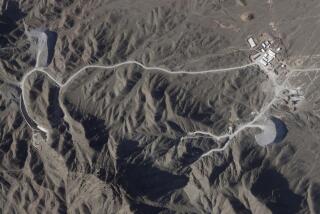Soviets Building Bunkers in Key Cities: Carlucci
- Share via
WASHINGTON — The Soviet Union has been pursuing an “enormously expensive” program of constructing huge underground bunkers and subways to protect its leaders and allow them to fight a protracted nuclear war, Defense Secretary Frank C. Carlucci said today.
While the existence of such complexes has been known for years, “only recently have we been able to do the full analysis of the enormous extent of this program--hundreds of meters deep, with subways under several cities,” Carlucci added.
“To have something comparable, we’d have to have facilities where we could put every governor, mayor, every Cabinet official and our whole command structure underground with subways running here and there. There’s just no comparison (with U.S. shelters built in the 1950s).”
Carlucci highlighted the Soviet Union’s so-called passive defense program as he released the 1988 version of “Soviet Military Power,” an unclassified study of what the Russian military has been doing over the past year.
The defense secretary cited the underground work as just one example of how Soviet actions paint a different picture than do the public statements of Kremlin leader Mikhail S. Gorbachev, with his emphasis on arms control initiatives and improving the economy.
An ‘Effective Response’
Without elaborating, Carlucci also made it clear that the United States is developing a means of threatening the underground bunkers.
“Although the (Soviet) program strikes at the very basis of deterrence, we have a number of initiatives under way that will provide us an effective response to this program at a fraction of the cost that it must have taken the Soviets to undertake it,” he said.
Last year, Defense and Energy department officials acknowledged that work had begun on a new family of “earth-penetrating” nuclear warheads for U.S. missiles.
“There can be only one purpose for these shelters--to provide the Soviet leadership the ability to fight a protracted, nuclear conflict,” Carlucci declared. “These facilities contradict in steel and concrete Soviet protestations that they share President Reagan’s view that nuclear war can never be won and must never be fought.”
The 1988 review, the last to be prepared by the Reagan Administration, is the seventh such assessment of Soviet forces. This year’s 175-page glossy publication differs substantially from the earlier reports, though, in that it tries harder to gauge who’s leading whom in various technologies and regions of the world.
More to Read
Sign up for Essential California
The most important California stories and recommendations in your inbox every morning.
You may occasionally receive promotional content from the Los Angeles Times.













